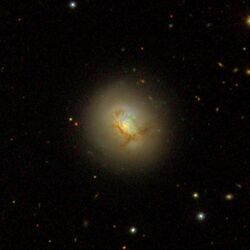Astronomy:NGC 7625
| NGC 7625 | |
|---|---|
 Sloan Digital Sky Survey image of NGC 7625 | |
| Observation data (J2000 epoch) | |
| Constellation | Pegasus |
| Right ascension | 23h 20m 30.132s[1] |
| Declination | +17° 13′ 32.16″[1] |
| Helio radial velocity | 1,630±3 km/s[2] |
| Distance | 78.3 ± 7.5 Mly (24.0 ± 2.3 Mpc)[3] |
| Apparent magnitude (V) | 12.9[4] |
| Apparent magnitude (B) | 12.94[5] |
| Characteristics | |
| Type | Sa/S pec[6] |
| Mass/Light ratio | 2.5[4] M☉/L☉ |
| Apparent size (V) | 1.6′ × 1.4′[5] |
| Other designations | |
| NGC 7625, Arp 212, UGC 12529, MCG+03-59-038, PGC 71133[7] | |
NGC 7625, or Arp 212, is a peculiar galaxy in the constellation of Pegasus. It was discovered on October 15, 1784, by William Herschel.[8] In his New General Catalogue (1888), J. L. E. Dreyer described it as pretty bright, considerably small, round, with a suddenly much brighter middle.[9] It is located at an estimated distance of 78 million light-years (24.0 megaparsecs) from the Milky Way galaxy.[3]
Halton Arp included NGC 7625 as object 212 in his Atlas of Peculiar Galaxies, indicating it displayed unexplained physical processes.[10] In the Third Reference Catalogue of Bright Galaxies, NGC 7625 was assigned a morphological classification of SA(rs)a pec, which indicates a peculiar spiral galaxy (SA) with a transitional ring structure (rs) and tightly wound spiral arms (a).[11] In 1981 it was designated a blue compact dwarf by T. X. Thaun and G. E. Martin on the basis of strong emission lines from ionized gas.[12] A prominent visible feature is an open ring of dust lanes with an angular radius of about 15″–20″.[13]
NGC 7625 displays indications of a recent interaction with another galaxy. Velocity measurements suggest the inner part of the galaxy is rotating in a different plane than the outer parts. The angle between these two planes increases with distance from the galactic center, reaching 50° at a radius of 6 kpc. Hence this may be a polar-ring galaxy, with the added gas accreted from the dwarf satellite galaxy UGC 12549.[13] There is a large amount of gas and dust undergoing significant star formation, with emission of H-alpha concentrated at the core and in separate knots along exterior curved structures.[6]
On October 28, 2023 type Ia supernova SN 2023vyl was discovered in this galaxy by ATLAS.[14]
References
- ↑ 1.0 1.1 Skrutskie, Michael F. et al. (February 1, 2006), "The Two Micron All Sky Survey (2MASS)", The Astronomical Journal 131 (2): 1163–1183, doi:10.1086/498708, ISSN 0004-6256, Bibcode: 2006AJ....131.1163S.
- ↑ Yu, Niankun et al. (August 2022), "Statistical Analysis of H I Profile Asymmetry and Shape for Nearby Galaxies", The Astrophysical Journal Supplement Series 261 (2): id. 21, doi:10.3847/1538-4365/ac626b, Bibcode: 2022ApJS..261...21Y.
- ↑ 3.0 3.1 Haynes, Martha P. et al. (July 2018), "The Arecibo Legacy Fast ALFA Survey: The ALFALFA Extragalactic H I Source Catalog", The Astrophysical Journal 861 (1): 49, doi:10.3847/1538-4357/aac956, 49, Bibcode: 2018ApJ...861...49H.
- ↑ 4.0 4.1 Demoulin, Marie-Helene (July 1969), "Observations of Galaxies with Large amounts of Dust. I. The Galaxy NGC 7625", Astrophysical Journal 157: 69, doi:10.1086/150050, Bibcode: 1969ApJ...157...69D.
- ↑ 5.0 5.1 Bratton, Mark (September 15, 2011), The Complete Guide to the Herschel Objects: Sir William Herschel's Star Clusters, Nebulae and Galaxies, Cambridge University Press, p. 362, ISBN 9781107376854, https://books.google.com/books?id=6EggAwAAQBAJ&pg=PA362.
- ↑ 6.0 6.1 Moiseev, A. V. (October 2008), Funes, José G.; J., S.; Corsini, Enrico Maria, eds., "3D Spectroscopy of the Ionized Gas Kinematics in Galactic Rings", Proceedings of the conference held 1–5 October 2007 at the Centro Convegni Matteo Ricci, Rome, Italy, Formation and Evolution of Galaxy Disks ASP Conference Series (San Francisco: Astronomical Society of the Pacific) 396: pp. 283–284, Bibcode: 2008ASPC..396..283M.
- ↑ "NGC 7625". SIMBAD. Centre de données astronomiques de Strasbourg. http://simbad.u-strasbg.fr/simbad/sim-basic?Ident=NGC+7625.
- ↑ Seligman, Courtney, "NGC Objects: NGC 7600 - 7649", Celestial Atlas, https://cseligman.com/text/atlas/ngc76.htm#7625, retrieved 2024-01-28.
- ↑ Frommert, Hartmut, NGC 7625, SEDS, https://spider.seds.org/ngc/ngc.cgi?NGC7625, retrieved 2024-01-28.
- ↑ Arp, Halton (November 1966), "Atlas of Peculiar Galaxies", Astrophysical Journal Supplement 14: 1, doi:10.1086/190147, Bibcode: 1966ApJS...14....1A.
- ↑ De Vaucouleurs, Gerard et al. (1991), Third Reference Catalogue of Bright Galaxies, Bibcode: 1991rc3..book.....D.
- ↑ Thuan, T. X.; Martin, G. E. (August 1981), "Blue compact dwarf galaxies. I. Neutral hydrogen observations of 115 galaxies", Astrophysical Journal 247: 823–848, doi:10.1086/159094, Bibcode: 1981ApJ...247..823T.
- ↑ 13.0 13.1 Moiseev, A. V. (September 2008), "Warped polar ring in the Arp 212 galaxy", Astrophysical Bulletin 63 (3): 201–215, doi:10.1134/S1990341308030012, Bibcode: 2008AstBu..63..201M.
- ↑ Supernovae 2023vyl in NGC 7625, Astronomy Section, Rochester Academy of Science, January 26, 2024, https://www.rochesterastronomy.org/sn2023/sn2023vyl.html, retrieved 2024-01-28.
Further reading
- Srivastav, S. et al. (October 2023), "ATLAS23urs (AT2023vyl): discovery of a candidate SN in NGC 7625 (23 Mpc)", Transient Name Server AstroNote 2023-284: 1, Bibcode: 2023TNSAN.284....1S.
- Karataeva, G. M.; Kuznetsov, A. N. (September 2008), "Observational study of the candidate polar-ring galaxies NGC 304 and NGC 7625", Astronomy Letters 34 (9): 608–619, doi:10.1134/S1063773708090041, Bibcode: 2008AstL...34..608K.
- Li, Jonathan G. et al. (August 1993), "The Molecular Gas and Star Formation in IRAS Bright Early-Type Disk Galaxies. I. NGC 7625", Astrophysical Journal 413: 150, doi:10.1086/172984, Bibcode: 1993ApJ...413..150L.
- Yasuda, Naoki et al. (February 1992), "CO Observations of the Peculiar Galaxy NGC 7625 and Detection of Infalling Molecular Gas", Publications of the Astronomical Society of Japan 44: 1–7, Bibcode: 1992PASJ...44....1Y.
- Brosch, N.; Loinger, F. (September 1991), "Extragalactic dust. IV. NGC 7625", Astronomy and Astrophysics 249: 327, Bibcode: 1991A&A...249..327B.
- Lynds, Beverly T.; Furenlid, Ingemar (December 1973), "Differential Colors of NGC 7625", Astrophysical Journal 186: 445–458, doi:10.1086/152511, Bibcode: 1973ApJ...186..445L.
- Lynds, B. T.; Furenlid, I. (June 1973), "Color Variations in NGC 7625", Bulletin of the American Astronomical Society 5: 349, Bibcode: 1973BAAS....5..349L.
 |

